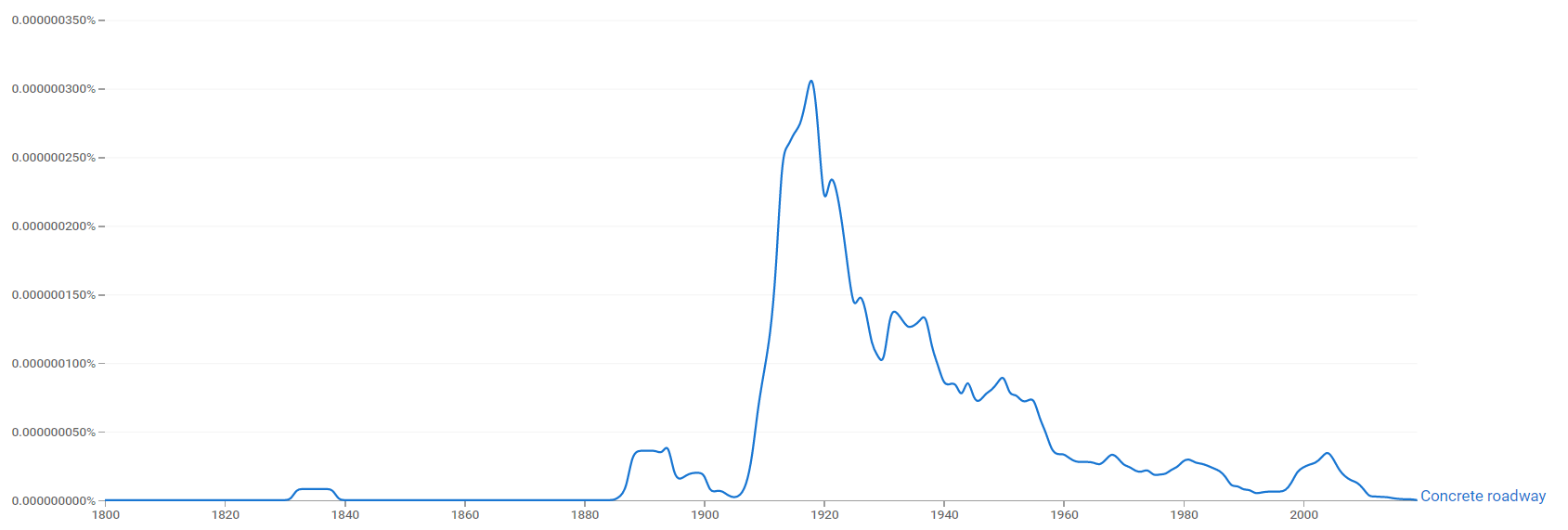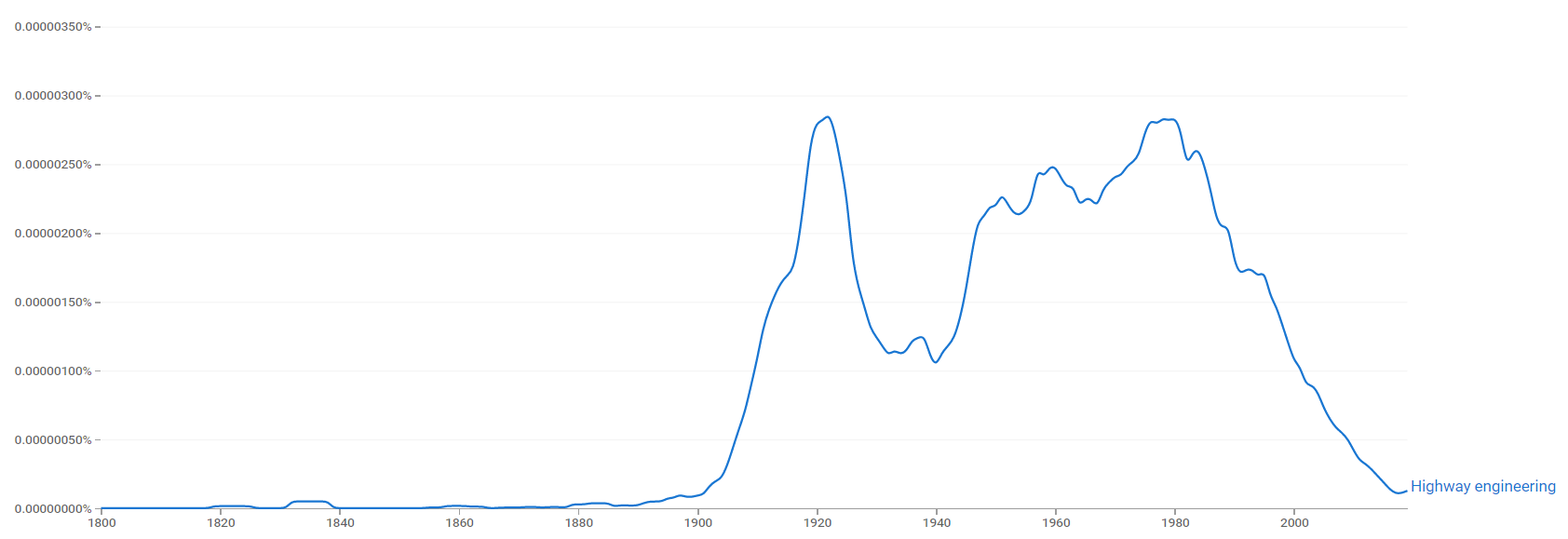Timeline of roads
This is a timeline of roads, attempting to describe major events in the development of roads, as well as the merge of novel transport vehicles meant for circulating on the former.
Sample questions
The following are some interesting questions that can be answered by reading this timeline:
- When and where did some early traffic regulations happen?
- When did some early road maps and books on roads first appear?
- When and where did some road-related inventions first appear?
- Which were important technological events concerning road construction development?
- When and where did some early modern highway systems merge?
Big picture
| Time period | Development summary |
|---|---|
| Ancient times | Metal tools available during the Bronze Age allow for the construction of stone paving of paths. At the same time, the use of wheeled vehicles (already well established in 2000 bc), increases the demand for paved roads.[1] Standard networks of roads were adopted by Romans, Persians, Aztec, and other early societies. However, in the ancient times, transport by river is far easier and faster than transport by road.[2] |
| 8th century | Many roads are built throughout the Arab Empire in the medieval Islamic world. The most sophisticated roads are those of Baghdad, Iraq, which are paved with tar.[3] |
| 12th century | Old cities revive and new ones are being built, especially in western Europe. Street paving becomes a reputable artisan activity.[1] |
| 15th century | In Europe, well-maintained roads gain critical importance, since they bring food to the cities from the hinterlands. At the same time, wheeled vehicles increase in number and quality. An awakened interest in better overland travel, better protection of merchants and other travelers manifest, as well as an interest in the improvement of roads.[1] In South America, the Incan road network covers 37,000 km, some of it through rugged Andean terrain. Over the next century, European explorers would praise these roads as superior to those in contemporary Europe.[4] |
| 18th century | Modern roads come into adoption during the late 1700s with civil engineering. Trésaguet establishes a scientific approach to road building. |
| 19th century | Sheet asphalt placed on a concrete base (foundation) becomes popular during the mid-century.[5] Telford and McAdam make substantial advances in the engineering of new roads. |
| 20th century | Modern highway systems develop as the automobile gain popularity. In the 1920s, landscape architects start becoming actively involved in highway design.[6] In the 1920s and 1930s, parkways proliferate in the United States.[6] In the 1970s, road safety measures make a big advance in many countries, partly as a result of the 1973 oil crisis.[7] |
| 21th century – recent years | Today, Eurasia, Africa, North America, South America, and Australia each have an extensive road network connecting most cities. According to the World Health Organization, more than 1 million people worldwide are killed on the roads each year.[8] |
Full timeline
| Year | Category | Details | Country/location |
|---|---|---|---|
| Earliest history | Non–human animals already trace pathways to cross the countryside by pushing aside vegetation and pounding the earth with their feet.[4] | ||
| 10000 BC | Pathways are being used by human travelers in temperate zones. Retreating glaciation permits their extension to the remainder of today's habitable world.[4] | ||
| 9000 BC | Background | Agricultural communities begin to rise.[4] | |
| 7000 BC | Background | Probable occurrence of large animal domestication.[4] | |
| 5000–2000 BC | Ridgeways date from this period, and are probably based on even older pathways.[4] | ||
| 4000 BC | Stone-paved streets are found in the city of Ur in the Middle East dating back to that time.[4] | Iraq | |
| 4000 BC | The oldest known road in the United Kingdom, a corduroy road in Glastonbury, England, coincides with the arrival of the first farmers to the island.[5][9] | United Kingdom | |
| 4000 BC | Mohenjo-daro cities in the Indus Valley Civilization covers its streets with crushed pottery and other materials so as to have a hard compacted surface.[10] | India | |
| 3500 BC | Technology | The Wheel is used by the Sumerians in Mesopotamia.[11] | Irak |
| 3200 BC | Technology | The first wheel for transportation purposes is built to move the Mesopotamian chariots.[11] | Irak |
| 2600–2200 BC | Technology | The earliest known paved road, made of flagstone, is constructed in Egypt.[12] | Egypt |
| 1500 BC | Many of the ways in eastern and central Europe are linked together into an extensive trading network known as the Amber Roads.[1] | Europe | |
| 800 BC | Early Greeks, though depending primarily on sea travel, build special roads for religious purposes and transport.[1] | ||
| 600 BC | Carthaginians are generally credited for being the first to construct and maintain a road system.[5] | Mediterranean Basin | |
| 500 BC | Darius I the Great starts building an extensive road system for Persia, including the famous Royal Road which would be considered one of the finest highways of its time. | ||
| 490 BC | Greeks are able to send messages at 200km/day by using runners in a relay system.[4] | Greece | |
| 490 BC | The Via Latina is built, stretching for about 200 kilometers.[13] | Italy | |
| 449 BC | The the Via Nomentana ius built between Rome and Nomentum.[13] | Italy | |
| 421 BC | The Via Labicana is built.[13] | Italy | |
| 361 BC | The Via Salaria is built.[13] | Italy | |
| 1585 | Publication | Italian engineer Guido Toglietta writes a treatise on a pavement system using broken stone. This represents a marked advance on the heavy Roman style.[1] | Italy |
| 1607 | Publication | Thomas Procter publishes the first English-language book on roads.[1] | |
| 1747 | Organization | The School of Bridges and Highways (École nationale des ponts et chaussées), is founded in Paris. It is the first highway engineering school in Europe.[1] | France |
| 1764–1775 | Technology | French engineer Pierre-Marie-Jérôme Trésaguet develops an entirely new type of relatively light road surface, based on the theory that the underlying natural formation, rather than the pavement, should support the load. His standard cross section is 18 feet wide and consists of an eight-inch-thick course of uniform foundation stones laid edgewise on the natural formation and covered by a two-inch layer of walnut-sized broken stone.[1] | France |
| 1791 | Policy | A traffic regulation in New York City establishes one-way traffic on a street.[14] | United States |
| 1793–1795 | The Philadelphia and Lancaster Turnpike, a privately constructed toll road, becomes the first engineered and planned road in the United States. The road connects Philadelphia and Lancaster in Pennsylvania, its 62-mile length has a maximum grade of 7 percent and is surfaced with broken stone and gravel in a manner initially uninfluenced by the work of Telford and McAdam. However, pavement failures in 1796 would lead to the introduction of some of the new European methods.[1] | United States | |
| 1816–1819 | Technology | Scottish engineer John Loudon McAdam writes two treatises, Remarks on the Present System of Road-Making and Practical Essay on the Scientific Repair and Preservation of Roads, arguing that roads need to be raised above the surrounding ground and constructed from layered rocks and gravel in a systematic manner. Being appointed surveyor to the Bristol Turnpike Trust, McAdam decides to remake the roads under his care with crushed stone bound with gravel on a firm base of large stones. A camber, making the road slightly convex, ensures rainwater rapidly drained off the road rather than penetrate and damage the road's foundations. This construction method, considered among the greatest advance in road construction since Roman times, becomes known as "macadamisation", or "macadam".[15][16] | United Kingdom |
| 1824 | Material | The first true portland cement (actually the most common type of cement in general use around the world) is patented and produced in the United Kingdom.[5] | United Kingdom |
| 1824 | Technology | Asphalt blocks are first used, on the Champs-Elysees in Paris.[17] | France |
| 1842 | An early wire suspension bridge is opened to traffic in Fairmount City, Pennsylvania.[18] | United States | |
| 1848 | Technology | The first tar macadam pavement is placed outside of Nottingham (Lincoln Road). Around this time, pavements are considered suitable only for light traffic (not for urban streets).[5] | United Kingdom |
| 1854 | Tar macadam projects are built in Paris.[5] | France | |
| 1854 | Tar macadam projects are built in Knoxville, Tennessee.[5] | United States | |
| 1858 | Technology | Sheet asphalt placed on a concrete base is built in Paris.[5] | France |
| 1865 | Material | Portland cement is introduced in the United States.[5] | United States |
| 1868 | Technology | The world's first traffic lights are installed in Parliament Square, London.[19] | United Kingdom |
| 1871 | Material | “Tar concrete” is extensively used in Washington, D.C.[5] | United States |
| 1875–1900 | Statistics | Trinidad island supplies about 90% of all asphalt worldwide is this period.[5] | Trinidad |
| 1888 | The city pharmacy in Wiesloch in Baden-Württemberg, becomes the first filling station, when starting to sell gasoline as a side business. Bertha Benz would refill the tank of the first automobile on its maiden trip from Mannheim to Pforzheim.[20] | Germany | |
| 1893 | Policy | France establishes driving licenses, including required tests.[7] | France |
| 1900 | Material | Cements are categorized as “natural” or “artificial.” Natural cements are those made directly from specific rock. Artificial cement is made from proportioned ingredients and becomes known as “Portland” (named after the Portland Bill in England).[5] | |
| 1901 | Vehicle | Oldsmobile becomes the first mass–produced car.[21] | United States |
| 1908 | The Long Island Motor Parkway on Long Island, New York, openes as a private venture. It is the world's first limited-access roadway, including many modern features, such as banked turns, guard rails and reinforced concrete tarmac.[22] | United States | |
| 1911 | The first limited access road in the United States is constructed in Long Island, known as the Long Island Motor Parkway or Vanderbilt Motor Parkway.[23] | United States | |
| 1911 | A painted line along Trenton's River Road in Wayne County, Michigan is the first documented use of a painted center line used for road surface marking.[24] | United States | |
| 1916 | Policy | The United States Federal Aid Road Act of 1916 is enacted, providing the first federal funding for building and improving roads in the country.[25] | United States |
| 1917 | American company Goodyear Tire and Rubber Company launches the interstate trucking industry in the United States.[5] | United States | |
| 1919 | Policy | Oregon introduces the first tax on gasoline at one cent per gallon, in order to fund road construction.[26] | United States |
| 1920 | Publication | American naturalist Joseph Grinnell, one of the earliest observers of roadkill, notes: "This roadkill is a relatively new source of fatality; and if one were to estimate the entire mileage of such roads in the state California, the mortality must mount into the hundreds and perhaps thousands every 24 hours. | United States |
| 1920 | The Paris Convention advises driving on the right-hand side of the road, in order to harmonise traffic across Europe.[27] | France | |
| 1921 | Policy | The United States Federal Aid Highway Act of 1921 (Phipps Act) enacts a fund to create an extensive highway system. | United States |
| 1921 | The Avus autobahn opens as the first high–speed dual carriageway with access limited to motor vehicles only.[28] | Germany | |
| 1922 | Publication | The Pershing Map, the first blueprint for a national highway system, is published.[29] | United States |
| 1924 | The Milano–Vareseautostrade opens as the first intercity highway, between Milan and Varese.[28] | Italy | |
| 1924 | Publication | American company Rand McNally publishes the first edition of road atlas “Auto Chum”.[25] | United States |
| 1926 | Statistics | The sale of pneumatic truck tires surpasses solids for the first time.[5] | |
| 1926 | The first network of numbered interstate highways is established in the United States.[25] | United States | |
| 1928 (August 30) | An early patent for a parking meter is filed by Roger Babson. The meter is intended to operate on power from the battery of the parking vehicle and requires a connection from the vehicle to the meter.[30] | United States | |
| 1932 | The Bonn–Cologne autobahn opens. Konrad Adenauer, the major of Cologne, states in his speech during the inauguration act: "That is what the roads of the future will look like".[31] | Germany | |
| 1933 | The UK Transport Research Laboratory is established in the United Kingdom. It conducts for the first time research dedicated to highway engineering.[32] | United Kingdom | |
| 1933 | Technology | The cat's eye design originates in the United Kingdom. | United Kingdom |
| 1948 | Publication (film) | The U.K. Central Office of Information produces a short film showing the correct way to use a pedestrian crossing (without the stripes at this time).[33] | |
| 1948 | The zebra crossing concept is born. Over the next years zebra crossings start being used in the United Kingdom.[34] | United Kingdom | |
| 1956 | Statistics | The United States Federal Aid Highway Act of 1956 allocates US$25 billion for the construction of 41,000 miles (66,000 Km) long Interstate Highway System over a 20-year period. | Unites States |
| 1958 | The first bypass route in the United States is completed as Alabama State Route 210 (Ross Clark Circle) in Dothan, Alabama. | Unites States | |
| 1973 | The idea that highway design could be influenced by acoustical engineering considerations first arises.[35][36] | ||
| 1992 | Speed cameras are introduced in the United Kingdom for enforcing speed limits.[28] | United Kingdom | |
| 2010 | Incident | The China National Highway 110 traffic jam outside Beijing occurs, lasting more than 10 days and stretching 100 kilometres.[37] | China |
| 2013 | Technology | Students at George Washington University install a solar panel walking path, calling it solar pavement.[38] | United States |
| 2014 | Technology | SolaRoad, the world's first bike path made from solar panels opens in the Krommenie, Netherlands. SolaRoad is also a prototype project testing the feasibility of various proposal for smart highways.[39][40][41] | Netherlands |
| 2014 | A glow-in-the-dark bike path inspired by Vincent van Gogh's The Starry Night is created with luminous paint in the Netherlands with the purpose to reduce urban light pollution.[42] | Netherlands | |
| 2014 | Statistics | Only 43% of rural Africans have access to an all-season road.[43] | Africa |
| 2015 | Technology | A freeway with the median covered by solar panels above a bikepath is built in South Korea.[44] | South Korea |
| 2016 | Technology | The first photovoltaic road in the world is constructed in Tourouvre, Orne, France.[45] The 1-km section of road opens to traffic on 22 December.[46] | France |
Numerical and visual data
Google Scholar
The following table summarizes per-year mentions on Google Scholar as of October 26, 2021.
| Year | "Highway engineering" |
|---|---|
| 1900 | 2 |
| 1910 | 7 |
| 1920 | 26 |
| 1930 | 20 |
| 1940 | 48 |
| 1950 | 41 |
| 1960 | 123 |
| 1970 | 128 |
| 1980 | 150 |
| 1990 | 305 |
| 2000 | 1,130 |
| 2010 | 6,950 |
| 2020 | 3,050 |

Google Trends
The comparative chart below shows Google Trends data for Solar road (Topic) and Plastic road (Topic), from January 2004 to April 2021, when the screenshot was taken. Interest is also ranked by country and displayed on world map.[47]

Google Ngram Viewer
The chart below shows Google Ngram Viewer data for Concrete roadway, from 1800 to 2019.[48]

The chart below shows Google Ngram Viewer data for Highway engineering, from 1800 to 2019.[49]

Meta information on the timeline
How the timeline was built
The initial version of the timeline was written by User:Sebastian.
Funding information for this timeline is available.
What the timeline is still missing
- https://timesofindia.indiatimes.com/auto/cars/israeli-firm-installs-norways-first-wireless-ev-charging-road/articleshow/111395133.cms
- Table: total length of the road network per sample country per year [1]
- Highway engineering
- Road surface
- Plastic roads
- List of road types by features
Timeline update strategy
See also
References
- ↑ 1.00 1.01 1.02 1.03 1.04 1.05 1.06 1.07 1.08 1.09 "Roads and highways". britannica.com. Retrieved 19 July 2017.
- ↑ O'Flaherty, Coleman A. (2002). Highways: The Location, Design, Construction & Maintenance of Road Pavements. Elsevier. ISBN 0-7506-5090-7.
- ↑ Dr. Kasem Ajram (1992). The Miracle of Islam Science (2nd ed.). Knowledge House Publishers. ISBN 0-911119-43-4.
- ↑ 4.0 4.1 4.2 4.3 4.4 4.5 4.6 4.7 Lay, M. G.; Vance, James E. Ways of the World: A History of the World's Roads and of the Vehicles That Used Them.
- ↑ 5.00 5.01 5.02 5.03 5.04 5.05 5.06 5.07 5.08 5.09 5.10 5.11 5.12 5.13 "Pavement History". pavementinteractive.org. Retrieved 2 August 2017.
- ↑ 6.0 6.1 Pregill, Philip; Volkman, Nancy. Landscapes in History: Design and Planning in the Eastern and Western Traditions. Retrieved 19 August 2017.
- ↑ 7.0 7.1 Demography - Analysis and Synthesis: A Treatise in Population. Retrieved 21 August 2017.
- ↑ Statistical Annex, World report on road traffic injury prevention
- ↑ Lay, Maxwell G (1992). Ways of the World: A History of the World's Roads and of the Vehicles that Used Them. Rutgers University Press. ISBN 0-8135-2691-4.
- ↑ "Mohenjo-daro - Indus Civilization Capital City in Pakistan". thoughtco.com. Retrieved 21 August 2017.
- ↑ 11.0 11.1 "History of the Wheel". autoevolution.com. Retrieved 24 July 2017.
- ↑ "World's Oldest Paved Road Found in Egypt". nytimes.com. Retrieved 18 July 2017.
- ↑ 13.0 13.1 13.2 13.3 "Ancient Roman Roads". legendsandchronicles.com. Retrieved 21 August 2017.
- ↑ "Joint Force Headquarters (JFHQ)-NJ conducted reconstitution and reintegration activities". nj.gov. Retrieved 20 August 2017.
- ↑ Alec Skempton, ed. (2002). A Biographical Dictionary of Civil Engineers in Great Britain and Ireland: 1500–1830. London: Thomas Telford. p. 416.
- ↑ "John L McAdam". about-bristol.co.uk. Retrieved 3 August 2017.
- ↑ "Interesting Facts You May Not Know About Asphalt". aceasphalt.com. Retrieved 20 August 2017.
- ↑ Jones, Barry. Dictionary of World Biography: Fourth edition. Retrieved 20 August 2017.
- ↑ "Who invented traffic lights and where were the first ones situated?". theguardian.com. Retrieved 20 August 2017.
- ↑ "Wiesloch — The World's First Filling Station". mygermancity.com. Retrieved 19 August 2017.
- ↑ Domm, Robert W. Michigan Yesterday & Today. Retrieved 2 August 2017.
- ↑ Patton, Phil (9 October 2008). "A 100-Year-Old Dream: A Road Just for Cars". The New York Times.
{{cite news}}:|access-date=requires|url=(help) - ↑ Kroessler, Jeffrey A. The Greater New York Sports Chronology. Retrieved 21 August 2017.
- ↑ Cranson, Jeff (November 2, 2011). "Inventor of Highway Centerline Receives International Honor" (Press release). Michigan Department of Transportation. Archived from the original on 21 August 2017. Retrieved January 8, 2012.
{{cite press release}}:|archive-date=/|archive-url=timestamp mismatch; 25 December 2011 suggested (help) - ↑ 25.0 25.1 25.2 "This 1916 Guide Shows What the First Road Trips Were Like". nationalgeographic.com. Retrieved 20 August 2017.
- ↑ "Oregon Started a Trend in 1919 with the Nation's First Gas Tax. Will It Do So Again?". huffingtonpost.com. Retrieved 21 August 2017.
- ↑ "Seventy-five years of driving on the right". radio.cz. Retrieved 21 August 2017.
- ↑ 28.0 28.1 28.2 Harrison, Ian. Take Me to Your Leader. Retrieved 27 August 2017.
- ↑ "National Highway System". thenmusa.org. Retrieved 21 August 2017.
- ↑ Hartson, William. "Top 10 facts about parking meters". express.co.uk. Retrieved 22 August 2017.
- ↑ Vahrenkamp, Richard. The German Autobahn 1920-1945: Hafraba Visions and Mega Projects. Retrieved 2 August 2017.
- ↑ O'Flaherty, edited by C.A. (2002). Highways the location, design, construction and maintenance of road pavements (4th ed.). Oxford: Butterworth-Heinemann. ISBN 978-0-7506-5090-8.
{{cite book}}:|first=has generic name (help) - ↑ "Public Information Films | 1945 to 1951 | Film index | Pedestrian Crossing". Nationalarchives.gov.uk. Retrieved 21 August 2017.
- ↑ Country, Black (26 November 2009). "All aboard the road to safety". Black Country Bugle. Retrieved 21 August 2017.
- ↑ Shadely, John (1973). Acoustical analysis of the New Jersey Turnpike widening project between Raritan and East Brunswick. Bolt Beranek and Newman.
- ↑ Hogan, Michael (17–18 April 1973). Highway Noise. 3rd Environmental Pollution Symposium, sponsored by AIAA, ACS, ASME, SAE. Menlo Park, CA: SRI International.
- ↑ "Bumper to bumper, all the way to Beijing". archive.org. Retrieved 2 August 2017.
- ↑ "Students Install the World's First Solar Pavement Panels in Virginia | Inhabitat - Sustainable Design Innovation, Eco Architecture, Green Building". Inhabitat. Retrieved 2 August 2017.
- ↑ de Wit, Sten; Saenz, Soraya Rosa; van Dieren, Jannemieke (21 October 2014). "SolaRoad opens: The first road in the world that converts sunlight into electricity is ready for use" (PDF) (Press release). SolaRoad.
- ↑ Spakovskis, Robert. "SolaRoad: World's first solar cycle path to open in the Netherlands". Phys.org. Retrieved 2 August 2017.
- ↑ Mlot, Stephanie. "The Netherlands Preps World's First Solar Road". PC Magazine. Retrieved 2 August 2017.
- ↑ Fischer, John (November 17, 2014). "Glow in the Dark Bike Path Inspired by Van Gogh's 'Starry Night'". Retrieved 21 August 2017.
- ↑ http://www.afdb.org/fileadmin/uploads/afdb/Documents/Publications/Tracking_Africa%E2%80%99s_Progress_in_Figures.pdf
- ↑ "The Daejeon-Sejong Bike Highway Is Solar Powered And Good For The Environment". techtimes.com. Retrieved 3 August 2017.
- ↑ "High Tech. Ségolène Royal lance la première route solaire dans l'Orne". ouest-france.fr. Retrieved 3 August 2017.
- ↑ "World's first solar panel road opens in Normandy village". theguardian.com. Retrieved 3 August 2017.
- ↑ "Solar road and Plastic road". Google Trends. Retrieved 26 April 2021.
- ↑ "Concrete roadway". books.google.com. Retrieved 26 April 2021.
- ↑ "Highway engineering". books.google.com. Retrieved 26 April 2021.